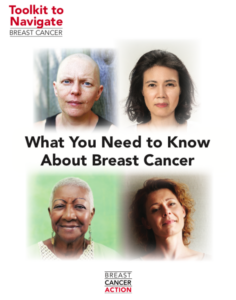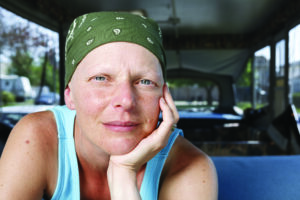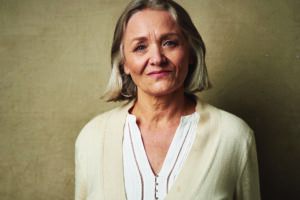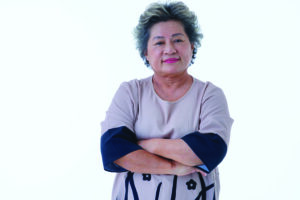
Overview and Introduction
What is Breast Cancer?
Types of Breast Cancer
Screening, Diagnosis and Treatment
Metastatic Disease
Side Effects and Health Harms of Treatment
Chemoprevention
Food and Drug Administration(FDA)Approval Standards
How to Keep Current
Breast cancer is both all too common and incredibly individual. It’s the most common cancer (excluding skin cancer) diagnosed in women living in the U.S. Although nearly 300,000 people are diagnosed with invasive breast cancer each year, no two people have the same experience. Each breast cancer diagnosis is unique and deeply personal.
The goal of our What You Need to Know About Breast Cancer document is to provide an overview of breast cancer and a framework to help understand a breast cancer diagnosis. There are many other resources that define medical terms and explain cancer biology, and this document does not replace those. Rather, this resource contextualizes the evolving science of breast cancer and provides a perspective that is not available elsewhere.
 Breast Cancer Action offers neither treatment nor medical advice. However, we do provide accurate, unbiased information that allows patients to make well-informed decisions about available treatments based on personal needs. We believe that breast cancer screening, treatment, and research must be patient-centered and responsive to the needs of those at risk of and living with breast cancer, and should not reflect corporate or industry bias that puts profits over patients.
Breast Cancer Action offers neither treatment nor medical advice. However, we do provide accurate, unbiased information that allows patients to make well-informed decisions about available treatments based on personal needs. We believe that breast cancer screening, treatment, and research must be patient-centered and responsive to the needs of those at risk of and living with breast cancer, and should not reflect corporate or industry bias that puts profits over patients.
Dramatic increases in the incidence of breast cancer in recent decades are a serious public health concern. And disparities in who gets and dies from breast cancer make it an important health justice issue.
As a grassroots organization committed to social justice we recognize that the commonalities in experiences of breast cancer are often reflective of larger systemic issues. At the same time, we honor the diversity of lived experience and respect that each person’s perspective is valid.
Our Tools and Tips for a New Breast Cancer Diagnosis provides additional resources to support informed decision-making and can be paired with this guide.
Breast cancer has been around for thousands of years. The word cancer comes from the Greek word carcinos, meaning crab, and early descriptions of diseases likely to be breast cancer can be found in ancient Egyptian and ancient Greek texts.
Cancers are usually identified by the organ in which they first develop. Even though breast cancers all originate from breast tissue, there are many different types of breast cancer. Understanding the specific subtype of breast cancer is important for knowing what it means for a person’s treatment and outcomes.
The breast itself is a non-vital organ, which is to say that people can live without breasts, and cancer that stays in the breast is unlikely to be fatal. However, sometimes breast cancer cells spread (metastasize) to other parts of the body. When this happens, someone may have breast cancer in their lungs, brain, liver, or bones.
When dealing with a new breast cancer diagnosis, there is a lot to learn about the specific type and stage of the disease. Data and statistics about the characteristics and extent of the cancer can help guide treatment decisions. But no statistic can predict with certainty what will happen in an individual case or how a person will respond to treatment. Each person is different, and treatment decisions are extremely personal.
Breast cancers are broken down and categorized in several ways, each of which helps to give a better understanding of how a specific breast cancer behaves and what treatments are most likely to be effective. Over the last 30 years, there has been a shift in how cancer doctors and researchers think about and categorize breast cancers. In the 1980s, breast cancers were primarily described in terms of tumor size and extent of the disease. By the 2000s, the tumor’s receptor status and molecular subtype became more meaningful ways to group breast cancers and recommend treatment. There is ongoing interest in understanding different subtypes and new ways to distinguish and categorize breast cancer. Currently, the common ways that breast cancers are categorized include:
The breast is a complex organ with specialized tissue and structure that includes milk-producing glands called lobules, and a system of ducts that transport milk to the nipple. Breast cancer can begin in any of these different areas of the breast.
Most originate in the milk ducts: 80% of all breast cancers are invasive ductal carcinoma (IDC), also sometimes called infiltrating ductal carcinoma. Invasive lobular carcinoma (ILC), sometimes called infiltrating lobular carcinoma, is the second most common type of breast cancer and represents about 10% of all breast cancers.
There are a number of much less common forms that each account for a small percentage of breast cancers. These may start in the cells of the chest muscle, fat, or connective tissue and include inflammatory breast cancer, Paget’s disease, sarcomas, phyllodes tumors, and angiosarcomas. Each of these rare forms is distinct and should be treated by a specialist in this subtype of breast cancer.
Doctors evaluate the size of the tumor and extent of the disease and use four stages to indicate how far it has progressed. Stage 1 indicates the cancer cells are confined to an area of less than two centimeters, and the lymph nodes are not involved. Stage 2 indicates some evidence that the cancer has begun to grow larger than two centimeters or has spread to the lymph nodes, but it is still considered relatively early-stage. Stage 3 indicates there is evidence that the cancer has begun to invade the surrounding tissues near the breast. Stage 4, or metastatic breast cancer, indicates that the cancer has spread to other areas of the body.
Cancer grade is a description of how the cancer cells look under a microscope, and a measure of how quickly the cells might grow or spread. Breast cancer is graded on a pathology report scale from 1 to 3, with a lower grade indicating less aggressive cancer. Pathologists examine the cancer cells to determine how different they are in appearance and growth from normal, healthy cells. Although higher grade cancers are considered more aggressive, they may be very responsive to chemotherapy and radiation treatments that target fast-dividing cells.
 Hormone positive: The majority of breast cancers are hormone positive, which means they grow in response to hormones. Up to 80% of all breast cancers are estrogen receptor positive, often called simply ER-positive or ER+, which means the cancer cells grow in response to the hormone estrogen. About 65% of these are also progesterone receptor positive, or PR-positive (PR+), and grow in response to another hormone, progesterone. These cancers are usually treated with hormone therapies in addition to surgery and radiation.
Hormone positive: The majority of breast cancers are hormone positive, which means they grow in response to hormones. Up to 80% of all breast cancers are estrogen receptor positive, often called simply ER-positive or ER+, which means the cancer cells grow in response to the hormone estrogen. About 65% of these are also progesterone receptor positive, or PR-positive (PR+), and grow in response to another hormone, progesterone. These cancers are usually treated with hormone therapies in addition to surgery and radiation.
HER2+: In about 20% of breast cancers, the cells overexpress, or make too many copies of, a protein known as HER2. In the mid 1990s the development of the drug trastuzumab (brand name Herceptin) represented a major breakthrough in the treatment of these aggressive, fast-growing cancers. Since then several newer targeted treatments have been developed to also target HER2+ breast cancers.
Triple negative: Just 10- to 20% of breast cancers are known as “triple negative” because they don’t have estrogen receptors or progesterone receptors and don’t overexpress the HER2 protein. In some cases, triple negative breast cancers are associated with inherited BRCA mutations.They are typically treated with chemotherapy, and there are no targeted treatments for these cancers because they are neither hormone positive or HER2 positive. But recently (2019), the FDA approved the first immunotherapy drug for triple negative breast cancer.
Molecular subtyping is mostly used in research settings as another tool to help guide researchers in studying new treatments. If you attend research conferences, you may hear about Luminal A, Luminal B, basal-like, HER2-enriched and normal-like breast cancers. The molecular subtype is related to HER2 and estrogen positivity, but helps researchers describe more deeply how the cancer might behave.
Cancer is a disease of aging, and it’s estimated that nearly half of all people living in the U.S. will get cancer in their lifetime. A complex range of factors influence each individual person’s risk, including genetics, lifestyle, environmental exposures, and chance.
You’ve probably heard the frequently repeated statistic that one in eight women will get breast cancer. This does not mean that one in eight women in the U.S. have breast cancer right now, but refers to lifetime risk – the likelihood a woman will develop breast cancer during her lifetime. Another way to say this is that seven out of eight women will not get breast cancer in their lifetime.
Although medical experts offer rough estimates of a woman’s risk based on factors such as age and family history, accurately assessing an individual woman’s breast cancer risk is difficult. There is no perfect way to determine individual risk. Some of the risk factors that are frequently discussed, such as breast feeding and post-menopausal weight gain, contribute very slightly to an individual’s risk of breast cancer. Other risk factors—such as being tall or a higher-weight baby at birth, contribute very slightly to an individual’s risk of getting breast cancer.
The risk of breast cancer goes up as a person ages. A woman in her 40s has a 1 in 65 (1.5%) chance of being diagnosed with breast cancer compared to a woman in her 70s who has a 1 in 25 (3.8%) chance of being diagnosed with breast cancer.
The most common risk factor for breast cancer is being assigned female sex at birth, but people of all genders may also get breast cancer. Even though it is the most common cancer besides skin cancer for women in the U.S., most white women overestimate their risk of breast cancer—one of the unfortunate effects of widespread “awareness” campaigns. Many women also overestimate their risk of recurrence after a breast cancer diagnosis. This can make difficult treatment decisions feel even harder.
Marginalized communities experience extreme disparities in health outcomes for many diseases and breast cancer is no different. Historically, breast cancer mortality rates have been higher for Black women (31%) than any other U.S. racial or ethnic group. While Black women’s incidence rates for breast cancer once were lower than white women in recent years Black women’s incidence rate (127.3) is similar to white women (131.6). Not far behind are Asian-Pacific Islander (95.6), and Hispanic (94.8) women.
When talking about risk of breast cancer, most people immediately think of family history. And many people are surprised to learn that 90% of all breast cancers are not associated with family history. For some families, inherited genes increase the risk of breast and some other cancers. It’s estimated that approximately 1 in 500 women have a harmful (or deleterious) mutation of their BRCA1 or BRCA2 genes. However, inherited BRCA mutations are more frequent among a few ethnic groups, such as Ashkenazi Jews. One in 40 Ashkenazi Jewish women has a cancer-associated BRCA gene mutation.
 All people of all genders have BRCA1 and BRCA2 genes, which are tumor suppressor genes that repair DNA damage that occurs through normal living. Having a harmful BRCA mutation dramatically increases the chance that someone will get cancer over the course of their lifetime, but not everyone with one of these mutations will get cancer. We encourage anyone who is concerned they may have a hereditary risk of breast cancer to seek independent genetic counseling to better understand the risk assessment tools and tests, the full range of options, and what this means for you. Genetic counseling is important not only to help interpret test results, but also to determine which tests are best based on family history and whether genetic testing is right for you.
All people of all genders have BRCA1 and BRCA2 genes, which are tumor suppressor genes that repair DNA damage that occurs through normal living. Having a harmful BRCA mutation dramatically increases the chance that someone will get cancer over the course of their lifetime, but not everyone with one of these mutations will get cancer. We encourage anyone who is concerned they may have a hereditary risk of breast cancer to seek independent genetic counseling to better understand the risk assessment tools and tests, the full range of options, and what this means for you. Genetic counseling is important not only to help interpret test results, but also to determine which tests are best based on family history and whether genetic testing is right for you.
Increasingly, researchers are turning attention to other genes which may increase the risk of breast cancer. For the most part, these genes are not nearly as well understood or as widely researched and therefore much less is known about how much risk is conferred to individuals who have these genetic mutations.
For more information about genetic testing, see Breast Cancer Action’s:
There is a growing body of evidence linking involuntary exposure to chemicals in the environment to increased breast cancer risks.
Lifetime exposures to a range of synthetic chemicals and toxins have been linked to a variety of health harms, including breast cancer. The President’s 2008-2009 Cancer Panel reported that “the true burden of environmentally-induced cancer has been grossly underestimated… [and] the American people—even before they are born—are bombarded continually with myriad combinations of these dangerous exposures.” Yet, very little research funding is devoted to environmental exposures that may increase the risk of breast cancer. Taking environmental exposures seriously challenges the narrative of the mainstream cancer industry that individuals are responsible for developing or preventing breast cancer.
The factors that influence breast cancer risk cannot be isolated and many are beyond individual control. For example, people of color are disproportionality exposed to toxic chemicals that may increase the risk of breast cancer in air, water, and soil pollution. The unequal burden of environmental injustice and racial injustice lead to poorer health outcomes.
Additionally, individual solutions such as shopping for toxic-free products and eating healthy are not equally accessible options for all communities. The focus on individual consumer choices reinforces the narrative that breast cancer risks are within our control, rather than the result of systemic oppressions, structural barriers, and government policies.
It’s easy to believe each person can control their risk of breast cancer by being aware of factors that might raise that risk. As much as we support healthy lifestyles and choices, we also know that there is nothing any of us can do to ensure we never develop breast cancer. Many women who do all the supposedly “right things” still develop breast cancer. Cancer is not your fault!
The most common symptom of breast cancer is a lump in the breast or chest area that is not normally there. Many healthy breasts are lumpy, and most lumps are not cancerous. In fact, 80% of breast lumps that are biopsied are not cancer—they are benign.
But you can’t tell whether a lump is cancer by the way it feels to you. Cancerous lumps have some features that make them feel different than non-cancerous lumps, but how they feel can differ from person to person. If you find a lump that is new or feels different to you, or feel thickening of the breast, you should be checked out by a healthcare provider right away.
Breast cancer can spread to the lymph nodes in the armpit or around the collar bone, so swollen lymph nodes or new lumps in those areas should also be checked by a healthcare provider.
Other possible signs of breast cancer can be swelling of all or part of the breast; redness of the skin of the breast; eczema of the nipple; dimpling of the skin; the nipple turning inward; nipple discharge other than breast milk; or pain. These symptoms can be caused by something other than cancer. For example, the most common cause of breast pain is changes in hormone levels caused by the menstrual cycle. Even though most of the time these symptoms do not indicate breast cancer, there is no way to be sure without getting it checked.
If you have concerns about any of these or other symptoms or changes, please be sure to talk with your healthcare provider. That way, if it’s cancer, you can start a treatment plan; if it isn’t, you can stop worrying.
For free, one-on-one breast cancer information and resources, reach out:
• phone: 415.243.9301
• email: info@bcaction.org

A large percentage of breast cancers are found by people and their partners, and we encourage everyone to be familiar with your body. However, there is a difference between getting suspicious symptoms checked out and actively looking for cancer when there are no symptoms.
Screening and surveillance are terms to describe looking for early signs of breast cancer in people who do not have symptoms. Neither screening nor surveillance can prevent breast cancer, but both aim to catch the disease in its early stages, when it is sometimes more treatable.
Screening is the term used to describe looking for early signs of breast cancer in women at average risk of developing the disease and who have no symptoms. Average risk means women who do not have a prior history of breast cancer, do not have a significant family history, and who have no other known risk factors.
Surveillance is the term used to describe monitoring women at higher-than-average risk of developing breast cancer. Women with a higher risk may have been diagnosed with breast cancer in the past, have a BRCA mutation, or have other known risk factors. Mammograms and MRIs can both be used for surveillance.
Mammograms and self-exams are both used for screening. Mammograms, x-ray images of breast tissue, are the most widely-used tool for routine breast screening, and for years, breast self-exam was promoted as part of an awareness and screening strategy. But today, research shows, and many doctors acknowledge that breast self-exams are not a reliable way to find breast cancer, nor do they improve survival if they lead to a breast cancer diagnosis.
Although it might seem like a good idea to look for early signs of breast cancer, it’s important to weigh the risks and potential benefits for all medical tests and procedures. Many people are surprised to learn that routine screening for breast cancer carries some common harms and risks, as well as potential benefit. Some of the documented harms and limitations of routine mammography screening include:
The identification of a cancer that is not and never will be life-threatening is called overdiagnosis and usually leads to overtreatment. According to several large studies, more than 1 in 5 (20%) of all breast cancers found by routine mammograms is due to overdiagnosis.
Overtreatment is when a person receives more treatment than they need or more than helps them. This can happen when someone receives treatment for an extremely slow growing (indolent) cancer that will not become symptomatic, let alone life-threatening. It turns out that finding and treating more early-stage breast cancers does not necessarily save more lives. It’s important when evaluating the efficacy of a medical intervention to ask not just if more people are diagnosed, but if these people are helped by being diagnosed and treated.
A screening mammogram that looks abnormal even though there is not cancer is called a false positive. False positives require follow-up procedures to determine whether the abnormality is cancer and can lead to scarring, stress, and additional financial costs.
A screening mammogram that looks normal even though there is in fact breast cancer is called a false negative. Routine screening mammograms miss about 1 in 5 (20%) of invasive breast cancers.
Despite widespread adoption, routine mammography screening has not been shown to reduce deaths overall (all-cause mortality) or reduce the number of women diagnosed with advanced breast cancer. Research has also found that neither self-exam nor clinical exam done by a trained healthcare provider reduce deaths from breast cancer. It is more likely that a woman will be overdiagnosed and overtreated as a result of a routine mammogram than that the mammogram will help her avoid death from breast cancer.
In order to make informed decisions we believe that each person should understand the harms and benefits associated with screening to determine if, when, or how often they participate in a screening process.
For more information about routine screening see:
While screening and surveillance tests look for cancer when there are no symptoms, diagnostic tests are used to find out if existing symptoms are caused by breast cancer.
Mammograms may be used to help diagnose breast cancer. Screening, surveillance, and diagnostic mammograms all use the same technology. While a diagnostic mammogram may help rule out cancer, a biopsy to check for cancerous cells is usually needed to know for sure if a symptom is breast cancer.
To learn more about your specific cancer and get important information to help with treatment options, your healthcare provider may recommend additional tests. For example, a full body CT or PET scan may be done to check if the cancer has spread to other parts of the body.
Some tests may also be done on tissue removed through a biopsy or in surgery to learn more about the specific type of cancer. For example, the cells will be tested for estrogen or progesterone receptors and for higher than average levels of the HER2 growth-promoting protein. Note: there are several ways to test for HER2 status. If your HER2 test results are borderline, it’s a good idea to ask if another HER2 test makes sense for you.
Genomic tests, such as Oncotype DX and MammaPrint, are increasingly used to help identify which patients are likely to benefit from chemotherapy, thereby reducing overtreatment of patients who are unlikely to truly benefit. These tests look at the activity of many genes at the same time in order to predict how aggressive the cancer is and how likely it is to come back or spread to other parts of the body, and whether aggressive treatment such as chemotherapy is needed.
People with a family history of breast or ovarian cancer, or who have other risk factors, may be recommended for genetic testing to find out if they have an inherited mutation on their BRCA1 or BRCA2 genes. Genetic testing is complex and can raise as many questions as it answers, and we strongly recommend that anyone considering genetic testing seek independent professional genetic counseling before deciding whether to be tested, and consult with a genetic counselor after testing to walk through test results, what they mean, and to best understand the impact on your options.
Not everyone needs or is a candidate for all of these tests. Your healthcare providers will suggest specific tests based on your circumstances and symptoms.
Different treatments for breast cancer have different goals. For example, some treatments are used to reduce the chance the cancer will come back, and other treatments attempt to reduce the growth of the cancer. Treatment recommendations are based on the specific type, extent, and characteristics of the cancer. Every treatment comes with potential risks and harms. Each person should have the opportunity to fully understand both the possible benefits and harms of a particular treatment in order to make their own treatment decisions, based on their values, priorities, and life circumstances. We encourage each person to take the time and seek the resources they need to make the choices that feel best for them.
One tool used to evaluate the benefits of treatment options is risk, measured in both relative risk and absolute risk. Relative risk, often expressed as a percentage increase or decrease, is the number that tells you how much something you do can change your risk. In comparison, absolute risk is your own overall risk. For example, when we say that a treatment will reduce the risk of recurrence by 50%, it does not mean you have a 50% chance of recurrence. It means if the original risk was 10%, it now goes down to 5%. The relative risk was reduced by 50%, and the absolute risk is now 5%. Proponents of various medical interventions sometimes use both relative and absolute risk to describe benefits or harms to either maximize the maximize benefits or minimize the apparent harms.
Note that treatment recommendations will likely be different for patients who have a deleterious BRCA mutation that is known to increase the risk of breast cancer, including the risk that a person who has already had breast cancer will develop a second breast cancer. When this happens, the new cancer is known as a second primary cancer, which is different from recurrent cancer.
For hundreds of years, surgery has been the primary way to treat breast cancer. Most people whose breast cancer has not spread to other parts of the body will have surgery to remove the cancer. Today, with improvements in both radiation and systemic treatments (like chemotherapy and targeted therapies), surgery is playing a smaller role in treatment to improve the chances of survival.
There are two basic surgical options: mastectomy to remove the entire breast, or lumpectomy to remove only the tumor and a small amount of healthy tissue. Most people who have a lumpectomy also have radiation treatment. Survival rates for both a lumpectomy and a mastectomy are nearly identical—in fact lumpectomy is slightly better for most women! Removing the entire breast does not improve survival rates for women at average risk of breast cancer. Similarly, removing the healthy breast that is not affected by cancer also does not improve survival rates for people at average risk.

Surgery is a major decision and different people will make different choices. The recovery and risks are different for these two surgical options. Mastectomy is a much bigger surgery, and as journalist Peggy Orenstein wrote, “Breasts don’t just screw off, like jar lids.” Our hope is that everyone has the information and support needed to make the decision that feels right to them.
Some people decide to have a breast reconstruction after a mastectomy, to create an artificial breast mound. There are several surgical techniques to do this, including implants under the skin and muscle, and using a flap of tissue from another part of the body.
After decades of concern about the risks of breast implants, the FDA has acknowledged a range of risks associated with the procedure, including a rare lymphoma, and autoimmune-related symptoms known as Breast Implant Illness. Because breast implants have been around for decades, there is now more information about the risks and harms, but it’s important to remember that every surgery and reconstruction technique carries specific risks and limitations. The decision whether and how to reconstruct a breast mound is extremely personal, and there are many resources to learn about reconstruction options.
Whatever the choice, for nearly all people who undergo mastectomy, there is little to no sensation on the chest after surgery. This means when someone says that a reconstructed breast “feels normal,” they are referring to how it feels to the hand that is touching the breast, not the sensation of the breast itself.
Around a third of those who have a mastectomy go flat, or do not have reconstruction. A recent swell in activism around destigmatizing this choice has had a powerful impact on the lives of people who consider themselves part of the flat community. Advocates for going flat have helped change the culture around not reconstructing, showing that however you are most comfortable in your body is the most beautiful choice. This culture shift pushes back on the stigma associated with foregoing breast reconstruction. For many patients, the medical decision to get reconstruction has been complicated by societal pressures and norms. Living without breast is neither unfeminine nor misguided, and individuals considering whether or not to reconstruct should be make decisions based on individual needs, wants, and values, as well as the harms and risks associated with the medical procedure.
Additionally with mastectomy, the surgeon will want to remove and examine some lymph nodes as an indicator of the chance of cancer being in other organs, even if microscopic. Removing cancerous lymph nodes does not help patients live longer and comes with a significant risk of lymphedema, a painful and sometimes disabling condition. In the past, it was common for surgeons to remove all lymph nodes (called full axillary node dissection) at the time of breast surgery. However, clinical trial data has convinced most surgeons to instead perform a sentinel node biopsy. This procedure allows doctors to identify, remove, and examine only the lymph node (or nodes) closest to the tumor, where any cancer cells are most likely to spread. It is important for people considering this procedure to discuss and agree in advance whether the surgeon will plan to remove more lymph nodes if the sentinel node comes back positive, a procedure that will be performed when the patient is unconscious on the surgery table.
For more information about surgery options, see Breast Cancer Action’s:
Ionizing radiation damages living tissue. Radiation can cause cancer, but it can also be used therapeutically to damage cancer cells, leading to cellular death to stop the cancer from continuing to divide and grow. Some people find it confounding that the same thing that can damage DNA and cause cancer is also used to treat cancer. Some surgeons believe that the harms of radiation can be limited by the dose of the radiation or the way it is delivered. There is a small risk of secondary cancer from radiation therapy, but improvements in radiation oncology over the last decade have significantly reduced the harms and risks so that for many breast cancer patients, the benefits outweigh the harms of radiation treatment.
Most women who undergo lumpectomy will also receive radiation therapy, or radiotherapy, after surgery to reduce the risk of recurrence. Additionally, some women who have a mastectomy may also have radiation therapy to reduce the chance the cancer will come back. In metastatic breast cancer, breast cancer that spread to other areas of the body, radiation therapy is used to control the cancer’s growth or relieve pain. For example, targeted radiation may be used to treat the spread of breast cancer to the brain or bones.
Because of the risks of radiation therapy (including heart damage, lung damage, and secondary cancers), it is important to identify who might be able to avoid radiation treatment without compromising survival rates. In some cases, older women with early-stage, non-aggressive breast cancer can avoid radiation treatment.
For people who do receive radiation treatment, one way to reduce the toxicity of radiation without compromising efficacy is to have a shorter duration at a higher dose, reducing the standard treatment from 5 weeks to 3. This is called hypofractionated radiation. It should be noted that there are financial disincentives for radiation oncologists to make this transition. Additionally, a drug-free way to reduce heart damage, especially for radiation treatment to the left breast, is to coordinate with the radiation team to do deep inspiration breath hold, holding your breath for brief periods so that the air in the lung creates a space to protect the heart.
For more information about radiation treatment, see Breast Cancer Action’s:
Chemotherapy drugs are frequently used in addition to other breast cancer treatments, to try to stop cancer cells from dividing and growing. There are many different chemotherapy drugs and they may be given intravenously or by pill.
For people whose breast cancer has not spread, chemotherapy may be used to reduce the risk of the cancer coming back as a recurrence. For people whose breast cancer has not spread, chemotherapy may be used to reduce the risk of the cancer coming back as a recurrence. Recurrence is when a cancer comes back after a time of not being detected. Local recurrence is when the cancer has come back at the same place or near where the first tumor was found. Distant recurrence is when the cancer has spread to another organ within the body.
For people with metastatic disease, chemotherapy may be used to stop the cancer from growing or spreading further, improve quality of life, and help patients live longer.
Chemotherapy can be given before or after surgery for people whose breast cancer has not spread. In the case of metastatic disease chemotherapy is usually used instead of surgery. Chemotherapy given before surgery is called neoadjuvant therapy. Some of the reasons to do this are to try to prevent the spread of the most aggressive cancers, to shrink larger tumors making surgery easier, and to evaluate the tumor response to therapy. For people with metastatic disease, chemotherapy is one of many systemic (whole-body) treatments available to manage the disease, and may be the first treatment given or may be given after other treatments stop working.
Side effects from chemotherapy include everything from temporary and mild symptoms to serious, permanent, or even life-threatening harms. As with all health decisions, it is important to weigh the benefits and the risks so that each person can make the decision that is best for them.
For more information about chemotherapy treatment, see Breast Cancer Action’s:
Most breast cancers are hormone-driven, meaning the presence of estrogen and/or progesterone can promote the growth of these breast cancers. Hormone therapy works in different ways to try to stop or slow the growth of hormone-sensitive cancers. Which treatment is used may depend on whether the person is in menopause or not.
 The most common hormone therapy is tamoxifen, which has been used for more than 30 years to treat hormone positive breast cancers. Tamoxifen is in a category of drugs called selective estrogen receptor modulators (SERMs) which bind to estrogen receptors throughout the body. When SERMs bind to estrogen receptors of some tissues (for example, breast tissue) they block estrogen. But tamoxifen can mimic estrogen effects in other tissue, such as the uterus and bone. In fact, tamoxifen has been labeled a carcinogen by some agencies because it increases the risk of endometrial cancer.
The most common hormone therapy is tamoxifen, which has been used for more than 30 years to treat hormone positive breast cancers. Tamoxifen is in a category of drugs called selective estrogen receptor modulators (SERMs) which bind to estrogen receptors throughout the body. When SERMs bind to estrogen receptors of some tissues (for example, breast tissue) they block estrogen. But tamoxifen can mimic estrogen effects in other tissue, such as the uterus and bone. In fact, tamoxifen has been labeled a carcinogen by some agencies because it increases the risk of endometrial cancer.
Aromatase inhibitors (AIs) are another category of hormone treatments. They are mostly used to treat hormone-sensitive breast cancer in women who have reached menopause. These drugs (including anastrozole, letrozole, and exemestane) block an enzyme called aromatase from making estrogen for the body after the ovaries stop producing it through menopause.
Typically premenopausal women are not offered AIs if their ovaries are not producing estrogen. A woman’s ovaries can be forced to stop working through ovarian suppression, a medical process that permanently or temporarily blocks the ovaries from functioning. This can be done through three types of ovarian ablation: surgery called oophorectomy, radiation, or ovarian suppression drugs (such as Lupron or Zoladex).
Because hormone therapy can impact quality of life and may also come with health harms for some women, it is important for each person to weigh harms and benefits.
For more information about hormone therapy, see Breast Cancer Action’s:
Arguably the one true breakthrough in breast cancer treatment in the last 25 years was the development of the targeted treatment trastuzumab (brand name Herceptin). The introduction of trastuzumab as the standard of care for Her2 positive breast cancers has reduced deaths from this aggressive type of breast cancer.
Unfortunately, trastuzumab does not work for everyone, and tumors can develop resistance to treatment. New therapies are being developed that work in different ways to target HER2 positive breast cancer including pertuzumab (Perjeta), lapatinib (Tykerb), and ado-trastuzumab emtansine (Kadcyla). It’s important to note that at the time of this writing, although these drugs show some effect on delaying recurrence, none of these drugs had been shown to improve overall survival.
A fascinating history which offers insights into the inherent challenges of drug development in the U.S. and includes the role of Breast Cancer Action’s early members is Robert Bazell’s book on the subject, Her-2: The Making of Herceptin, a Revolutionary Treatment for Breast Cancer.
For more information about Her2+ targeted treatments, see Breast Cancer Action’s:
Targeted cancer therapies have proven to be elusive but remain one of the main areas of cancer research. The hope is that treatments that target specific characteristics of cancer cells will be both more effective than existing treatments and less harmful to normal, healthy cells.
Recent success with immunotherapy for other kinds of cancer has sparked a resurgence in interest in immunotherapy research for breast cancer, particularly for those with triple negative breast cancer. Immunotherapy is different from chemotherapy in that it utilizes the body’s own immune system to attack the cancer cells. Recent evidence shows improved progression free survival, the length of time during and after treatment that the individual lives with breast cancer without it getting worse. Breast Cancer Action believes treatments should be approved on the basis of overall survival benefit. As of 2020, overall survival benefit has also been demonstrated by some immunotherapy treatments, which means these drugs are no longer considered to experimental. Despite clinical outcomes, there is still concern about expense of immunotherapies.
For more information about evaluating new treatments, see Breast Cancer Action’s:
When breast cancer spreads to other parts of the body, it is called metastatic, or Stage 4 breast cancer. The most common places that breast cancer spreads are the bones, brain, liver and lungs. When this happens it is still breast cancer. Although metastatic breast cancer currently cannot be cured, it can be treated and the focus for treatment for metastatic breast cancer is length and quality of life.
 Sometimes breast cancer is metastatic at diagnosis (de novo). Other times the breast cancer spreads after the initial diagnosis, often many years after a person is first diagnosed. The national database that tracks cancer, the SEER database, only includes information on the initial stage at diagnosis, and not on how many people go on to develop metastatic disease. This leaves a large gap in data on metastatic breast cancer. It is estimated that around 168,000 people in the US are living today with metastatic breast cancer. Between 20% and 30% of people with early-stage breast cancer will go on to develop metastatic disease.
Sometimes breast cancer is metastatic at diagnosis (de novo). Other times the breast cancer spreads after the initial diagnosis, often many years after a person is first diagnosed. The national database that tracks cancer, the SEER database, only includes information on the initial stage at diagnosis, and not on how many people go on to develop metastatic disease. This leaves a large gap in data on metastatic breast cancer. It is estimated that around 168,000 people in the US are living today with metastatic breast cancer. Between 20% and 30% of people with early-stage breast cancer will go on to develop metastatic disease.
People with metastatic disease face specific additional issues, and treatment decisions are often different from those with an early-stage diagnosis will make. Because cancer can evolve and change over time, it is important to retest to make sure that treatments are targeted to the current tumor type.
For more information on metastatic breast cancer, see Breast Cancer Action’s:
Chemoprevention is the use of cancer treatments by healthy people to lower the risk of cancer. Breast Cancer Action has long questioned any large scale strategy of “pills for prevention” and instead urges research and resources to go toward true primary prevention. Too often, efforts that promote chemoprevention define “high risk” as any woman age 60 or older. This implicitly defines older women as “sick” and in need of treatment — in effect pathologizing the normal process of aging for women.
However, some people whose risk of breast cancer is significantly higher than average may want to consider various ways of reducing their individual risk. An inherited BRCA1 or BRCA2 mutation is the most well-understood risk factor and people with these mutations should weigh the risk and potential benefit of several risk-reduction and surveillance strategies to decide what is right for them.
Studies of chemoprevention have shown that the vast majority of people who take the drugs will not benefit, most often because they would never have developed cancer anyway, but also because the risk-reducing drug does not always prevent someone from getting cancer. Defining “high risk” too broadly means that a lot of people are unnecessarily exposed to the harmful effects of powerful anti-cancer drugs.
The “number needed to treat” (NNT), which is the average number of patients who will be treated for every one person who will avoid a bad outcome compared to a control arm in a clinical trial, is an important way to assess studies when considering chemoprevention: How many people do not benefit for every one person who does benefit?
Promoting large-scale chemoprevention is not a good public health strategy even though it expands the potential market, thus generating more profits for Pharma and biotech. In addition to exposing a lot of people to the harmful side effects of powerful cancer drugs, it also diverts focus and resources away from finding and eradicating environmental causes of, as well as more effective treatments for, breast cancer.
For more information about chemoprevention, see Breast Cancer Action’s:
Many breast cancer treatments come with a range of short and long-term harms. Some side effects are temporary and some are permanent. Some complications are rare and some health harms are common. Each person responds differently to treatment, and healthcare providers should discuss potential side effects, complications, and health harms when discussing treatment options.
 Many of the most serious side effects are not visible to other people. Although hair loss is one of the first things people think of when listing side effects of cancer treatment, many people are surprised to meet a person in treatment for breast cancer who has their hair. The reality is that not everyone treated for breast cancer gets chemotherapy, and not all chemotherapies result in hair loss. Examples of possible effects that other people cannot observe include short-term quality of life effects (like diarrhea or joint-pain) or long-term impacts (like nerve damage/neuropathy, bone loss, and cataracts).
Many of the most serious side effects are not visible to other people. Although hair loss is one of the first things people think of when listing side effects of cancer treatment, many people are surprised to meet a person in treatment for breast cancer who has their hair. The reality is that not everyone treated for breast cancer gets chemotherapy, and not all chemotherapies result in hair loss. Examples of possible effects that other people cannot observe include short-term quality of life effects (like diarrhea or joint-pain) or long-term impacts (like nerve damage/neuropathy, bone loss, and cataracts).
Some side effects of treatment may be potentially life-threatening, such as stroke, blood clots, secondary cancers such as endometrial or uterine cancers, and heart damage. Heart problems can be caused by a number of breast cancer treatments, including chemotherapy, radiation, some hormone therapies, and some targeted therapies. Serious cardiac problems or even heart failure may occur many years after treatment. Some researchers have expressed concern that women treated for early-stage breast cancer are at greater risk of dying from cardiovascular disease than breast cancer. This sobering reality prompted the American Heart Association in 2018 to issue a warning for women with breast cancer to weigh the benefits of specific treatments against the potential damage to the heart.
A breast cancer diagnosis is more than physical; it often comes with financial and emotional issues. Fear and sadness about mortality, grief about loss of fertility, and mood swings and depression associated with some treatment drugs are just some of the psychological and emotional impacts of breast cancer. There is no single “normal” or “right” way to feel about a breast cancer diagnosis and treatment.
Informed decision-making means knowing as much as you can about both the possible benefits as well as the possible side effects, complications, and harms of treatment. We encourage you to seek a range of resources to help you understand, manage, and even prevent treatment-related side effects, including speaking with healthcare professionals as well as others who have been through a breast cancer diagnosis. Breast Cancer Action offers balanced, evidence-based information through our Information and Resources line at 415.243.9301, our blog, webinars, and brochures to help you make these decisions.
For more information about treatment side effects and toxicities, see Breast Cancer Action’s:
For free, one-on-one breast cancer information and resources, reach out:
• phone: 415.243.9301
• email: info@bcaction.org
Breast Cancer Action has advocated for more effective, less toxic treatments since our founding in 1990. Despite the billions of dollars spent on awareness, breast cancer treatments remain largely the same as they were decades ago. Activists and health providers alike worry that the basic treatments for breast cancer continue to be “slash, burn, poison”—more commonly referred to in medical offices as surgery, radiation, chemotherapy—with too few advances benefitting too few women.
From a patient perspective, treatments work if they (1) help people live longer (improve overall survival), (2) help people live better (improve quality of life), or (3) cost less (so that more people have access and aren’t bankrupted by treatment). If a treatment doesn’t do one of these three things, the companies who sell it may benefit, but breast cancer patients do not. Until a new treatment has been shown to do one of these three things, we believe it should not be approved by the Food and Drug Administration (FDA).
In the face of slow medical advances, with true breakthroughs few and far between, the FDA too often gives in to pressure to approve new cancer drugs for the sake of saying they’ve approved new treatments. But fast approvals don’t help patients if the drugs in question are ineffective or unsafe. And granting FDA approval of essentially experimental drugs drives up medical costs without advancing health and wellbeing.
We believe that the best way to incentivize the development of desperately needed safe and effective new treatments is for the FDA to uphold high drug approval standards. The real barrier to breast cancer patients receiving more effective, less toxic treatments is scientific, not regulatory. Lowering standards for safety and efficacy will not speed up innovation but instead threatens to lower the quality of treatments that come to market.
Of course, there are times when available treatments don’t work and someone may want to try an experimental treatment. The main way is through participation in a clinical trial. But not everyone qualifies for or has access to a clinical trial. When someone cannot participate in a clinical trial, and available treatments are ineffective, patients may be provided access to promising experimental treatments through the FDA’s compassionate access programs. Additionally, with the passage of the federal Right to Try law in 2018, physicians may directly request access to experimental therapies from companies, without the oversight of the FDA. While this may seem appealing, the FDA’s compassionate use program has several advantages compared to Right to Try, including important patient protections.
For more information about the drug approval process, see Breast Cancer Action’s:
For 30 years, Breast Cancer Action has been a rapid response watchdog for the breast cancer movement. We don’t take funding from pharmaceutical or biotechnology companies. That means you can always trust we’ll tell the truth about breast cancer, and put your health first.
It seems that breast cancer research makes the headlines every few weeks, but too often the media hype makes it hard to know what’s real and what the study means for you. At Breast Cancer Action, we work to keep you updated and informed on the latest news in breast cancer—all from a patient perspective and free from Pharma influence. Go to www.BCAction.org/signup and sign up to receive the latest information at no charge. It’s easy to do:
Together with people like you, we are working for a world where lives and communities are not threatened by breast cancer. We’re in this with you and we know we’re stronger when we raise our voices together. Join us!
Please use this packet along with our Tools and Tips for a New Breast Cancer Diagnosis for people who have been newly diagnosed and their caregivers, with practical information and useful tools during diagnosis, treatment, and beyond.